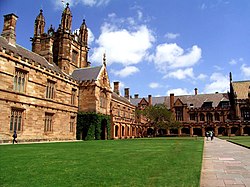History
The School of Chemistry was established as a part of the Faculty of Science in 1882. [3] However, chemistry was taught at the University of Sydney since 1852. A purpose-built building was constructed on what was later named Science Road starting in 1888 and was completed in 1890. The building was designed largely by Archibald Liversidge, Professor of Chemistry and the first Dean of the Faculty of Science. The original Chemistry Building is now used by the Sydney Pharmacy School.
In 1945, a large fibro-cement building (known as "Tramsheds") was constructed for use by chemistry students until the current Chemistry Building opened in 1958. The current Chemistry Building is notable in architectural history as one of the first structures in Australia with a curtain wall design.
Centres and initiatives
Drug Discovery Initiative
The Drug Discovery Initiative (DDI) was launched in 2018 to develop new drugs by working with clinicians and industry [9] in infectious diseases, cancer, inflammation, neurodegenerative disorders, and metabolic diseases. However, the DDI is not limited to these areas and its research has contributed to antibiotics, [10] cardiovascular diseases, [11] and other health issues. Much of the research of the DDI uses facilities made available by Sydney Analytical such as X-ray scattering techniques and various types of spectroscopy, usually for characterisation of new drugs or proteins. [12] Recent research within the DDI include Alzheimer's disease, malaria, and tuberculosis. [13] [14]
The current Academic Director of the DDI is Prof. Michael Kassiou.
Key Centre for Polymers and Colloids
The Key Centre for Polymers and Colloids (KCPC) is a research centre of the School of Chemistry established by the Australian Research Council Research Centres Program. [15] While the KCPC is known for polymers and colloids, it comprises several groups that can specialise in different areas like self-assembly, virus mimics, emulsions, and surfactants. [16] [17] The KCPC has attracted various industry support such as Orica, Nuplex Industries, and others. Currently, faculty members involved in KCPC research are: A/Prof. Brian Hawkett, A/Prof. Chiara Neto, Dr. Mohammad Choucair, Prof. Greg Warr, Dr. Markus Muellner, and E/Prof. Les Copeland.
The current KCPC Director is A/Prof. Brian Hawkett.
Academics
Admission
Admission to the School of Chemistry's research programs is competitive. Generally, admission to the School of Chemistry Honours program requires a SCIWAM of at least 65 or equivalent. Each faculty member is limited to 2.5 full-time equivalent (FTE) Honours students to ensure adequate supervision where co-supervised projects count as 0.5 FTE for each faculty. [18] As a result, admission for some projects is significantly more competitive than others.
The School of Chemistry offer postgraduate research degrees in the Doctor of Philosophy, Master of Philosophy, and Graduate Diploma in Science where admission is by application to the University of Sydney. [19] Applications for funding and scholarships is a separate application but also to the University of Sydney, this is a competitive process and a successful candidate is typically offered a stipend and a scholarship to cover living expenses and tuition fees, respectively. [20]
This page is based on this
Wikipedia article Text is available under the
CC BY-SA 4.0 license; additional terms may apply.
Images, videos and audio are available under their respective licenses.


